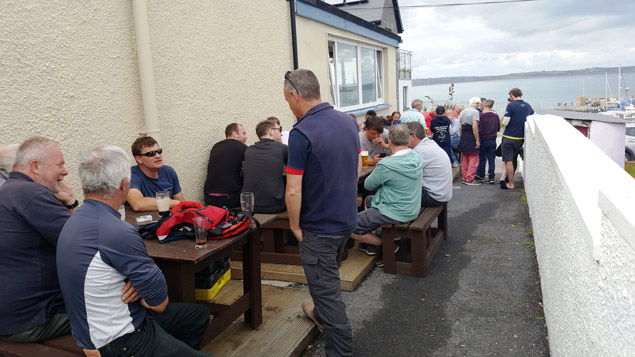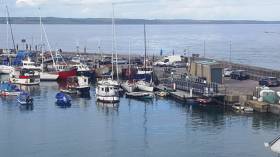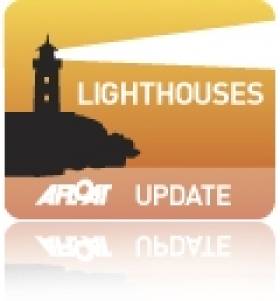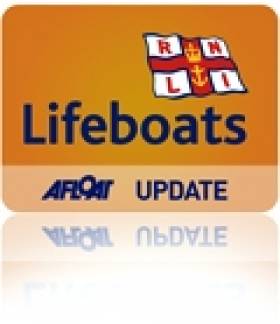Displaying items by tag: Ballycotton Lighthouse
Rounding Ballycotton Lighthouse on Saturday afternoon was satisfying, after a long beat from Crosshaven in the restored Royal Cork Ballycotton Race.
Over the 15-mile course which took about three hours a Northerly breeze veered through to an Easterly whisper and then - nothing. Coracle set the pace from the Grassy start line. As the course pulled rounded Roches Point the Easterly wind kicked in intermittently. Altair hugged the coast and as the white sails of Loch Gréine, Plumbat and Luna Sea followed this line those flying spinnakers no long benefited from the big sail. Passing Power Head the fleet split with the majority heading out to sea to avail of a tidal push while Altair and YaGottaWanna hunted breeze and wind lifts inshore.
As the fleet closed on Ballycotton Lighthouse Altair pulled a lead over Coracle, rounding Ballycotton Island and heading for the finish in what was becoming a very soft breeze, Coracle and YaGottaWanna rounded as the wind died further, with Loch Gréine and the kites of Cavatina and Scribbler II edging to the finish line. Plumbat and Luna Sea, in whitesail. without the option of a kite and no wind had to retire.
 Relaxing in Ballycotton after the sailing
Relaxing in Ballycotton after the sailing
Results: IRC – 1st Altair (K.Dorgan/J.Losty); 2nd Coracle (Kieran Collins); 3rd Ya Gotta Wanna (David Lane/Sinead Enright). ECHO – 1st Loch Gréine (Tom/Declan O’Mahony); 2nd Scribbler (Tom/Cormac MacSweeney); 3rd Cavatina (Ian Hickey). Gas Rigs Trophy/ECHO and Paddy and Peg Walsh Trophy/IRC– Altair. Jim Donegan Trophy, Best Family Boat – Coracle.
This is a race which was traditional and the RCYC Cruiser Classes are interested in getting more boats involved in coastal racing. It has invited those interested, boatowners or potential crews to make contact with the club.
Launch of Ballycotton Island Lighthouse Tours
#LighthouseTours – Tours of Ballycotton Island Lighthouse in East Cork, where officially launched last week in conjunction with the Commissioners of Irish Lights.
The landmark lighthouse built in the mid-1800s has opened its doors to the public for a new tourism initiative off the sunny south-east coast.
Yasmine Hyde, founder of Ballymaloe Relish is at the helm of this new venture. After successfully securing €90,000 in funding from SECAD, the South and East Cork Area Development fund, this exciting not-for-profit company was launched in the scenic fishing village situated 40k from Cork City.
Ballycotton Island Lighthouse Tours offer an exhilarating and magical experience where you can travel to the island in an open topped 12-passenger boat named 'Yassy'. While you are there you can explore the lighthouse while enjoying the stunning views from the lantern balcony.
The Commissioners of Irish Lights wish Ballycotton Island Lighthouse Tours every success for the future. For more information visit: www.ballycottonislandlighthousetours.com
Sailor Rescued from Burning Boat off Cork Coast
Youghal and Ballycotton lifeboat stations responded to the call and Ballycotton lifeboat station spoke of how they could see the black smoke in the distance as they rushed to the lifeboat station. An angling boat in the vicinity recovered the lone sailor from the sea. He was transferred to another angling boat and was immediately taken to Youghal where his condition was assessed by medical personnel.
Youghal and Ballycotton lifeboats were requested by the Coastguard to remain on scene while the pleasure craft blazed. Approximately an hour later the boat sank and the lifeboats returned to station.
Related Safety posts
RNLI Lifeboats in Ireland
Safety News
Rescue News from RNLI Lifeboats in Ireland
Coast Guard News from Ireland
Water Safety News from Ireland
Marine Casualty Investigation Board News
Marine Warnings































































